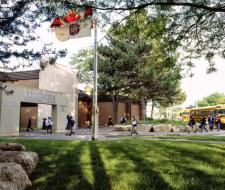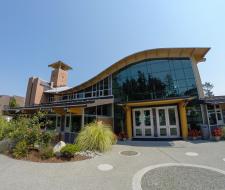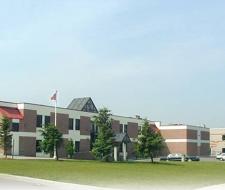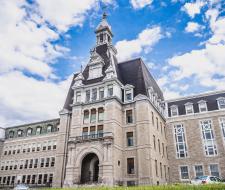Secondary education in Canada for international students - 3 yo
- Top Schools in Canada for Secondary Education
- Life in Canadian Schools for International Students
- Why Choose Secondary Schools in Canada: 9 Benefits for International Students
- Secondary Schools in Canada. Cost and Fees
- How to apply to best schools in Canada for foreign students?
- Literature and references
This content was developed and approved with active participation of Lucy Heller.
In the process of preparing the material, we referenced the following sources:
- https://www.hotcoursesabroad.com/study-in-canada/applying-to-university/the-canadian-higher-education-system-simplified/
- https://www.timeshighereducation.com/student/where-to-study/study-in-canada.
-

-
 100 % University placement from each graduating class
100 % University placement from each graduating class CanadaToronto, OntarioCurrently watching: 6
CanadaToronto, OntarioCurrently watching: 6 -
 In 2020 the highest grade received towards the IB Diploma - 40
In 2020 the highest grade received towards the IB Diploma - 40 CanadaVictoria, British ColumbiaCurrently watching: 8
CanadaVictoria, British ColumbiaCurrently watching: 8 -
 65 sport and clubs in PC's co-curriculum program
65 sport and clubs in PC's co-curriculum program CanadaToronto, OntarioCurrently watching: 9
CanadaToronto, OntarioCurrently watching: 9 -
 CIC has more top universities in the partnership program than any other school
CIC has more top universities in the partnership program than any other school CanadaToronto, OntarioCurrently watching: 7
CanadaToronto, OntarioCurrently watching: 7 -
 100 % University placement from each graduating class
100 % University placement from each graduating class CanadaToronto, OntarioCurrently watching: 7
CanadaToronto, OntarioCurrently watching: 7 -
 Top Areas of Study in 2023: STEM – 41 % Medical and Health – 12 %
Top Areas of Study in 2023: STEM – 41 % Medical and Health – 12 % CanadaOttawa, OntarioCurrently watching: 6
CanadaOttawa, OntarioCurrently watching: 6 -
 This past year, 70% of the graduating class received an offer of admission from their firs
This past year, 70% of the graduating class received an offer of admission from their firs CanadaVictoria, British ColumbiaCurrently watching: 6
CanadaVictoria, British ColumbiaCurrently watching: 6
Canada is one of the most popular country for studying abroad. It's famous all over the world for excellent quality of education and its low cost. Studying at 40 best secondary schools in Canada highly increases chances to enter world leading universities in the future. Foreign students have a great opportunity to use modern equipment, communicate with native speakers as teachers and study interesting programs.
Studying in Canada is popular due to several reasons:
- Modern Canadian primary and secondary education programs in Canada based on European and North American experience;
- Comfortable studying and living conditions;
- Low tuition fees;
- Diploma of the international standard
Alternative destinations
Top Schools in Canada for Secondary Education
The top 40 secondary schools in Canada offer dynamic programs that cater to both English and French speakers. By attending these leading schools, international students can significantly enhance their linguistic skills in two foreign languages, gain insights into Canadian culture and traditions, and chart a clearer path for future specializations. After completing their program at these top Canadian schools, students are often eligible to enroll in universities without the need for entrance examinations.
Studying in many Canadian schools often stipulates accommodation in a host family. However, foreign students are provided with the opportunity to live on campus with classmates. These schools are leading in the integration process of the latest technological advancements into their studying process. As a result, students are provided with access to innovative studying tools. By taking preparatory courses, in Canada, foreign students significantly improve language skills in English, allowing them to effectively study compulsory subjects.
Upon completing secondary education in Canada, students receive a certificate bearing their exam scores. In Canada, children aged from 6 to 16 years attend school, which is compulsory for all. Among more than five million students in Canadian schools annually, 95% enter public or Catholic schools. While public schools offer co-ed education, Catholic schools typically segregate by gender. Only 5% of students attend private schools, known for their prestige and higher tuition fees.
Interestingly, many international students gravitate towards private institutions in Canada. One appealing aspect of these institutions is their affordability; their programs are generally more cost-effective compared to boarding schools in the US, UK, and Switzerland.

What will you get after graduating Best Schools in Canada
The environment at the 40 best schools in Canada is one of the main draws for international students. Beyond just the allure of competitive pricing, Canada offers a welcoming and safe community. The educators are keenly invested in both academic pursuits and ensuring students have an engaging, fulfilling experience outside the classroom.
For those interested, some secondary schools in Canada offer separate housing for boys and girls, a practice that has been seen to benefit students by offering specialized academic and extracurricular programs tailored to foster academic, creative, and communicative growth.

TOP Canadian boarding school rankings - what criteria are they based on? How accurate is it today?
There are no official school rankings (as universities) in Canada; many of the private rankings are paid for by schools that want to be included. I think we need to look at the opportunities that the school provides - living conditions, the number of people in the class, the percentage of admission to universities, the availability of additional programs (STEM, art, etc.), the presence of IB, participation in Olympiads.
Life in Canadian Schools for International Students
Canadian boarding schools boast top-notch accommodation. Students typically reside in single or shared rooms and benefit from the constant guidance of educators living within the same premises. This close-knit setting aids students in acclimating to a new culture and environment.

Why Choose Secondary Schools in Canada: 9 Benefits for International Students
-
The senior school program, known as the High School Diploma, spans four years. Completion grants students a recognized graduation certificate, opening doors to universities in Canada, the US, and other English-speaking countries.
-
Age flexibility: Students don't need to be 18 to start university.
-
Cost-efficiency: For instance, the Pre-University program at Columbia International College was priced at only 35,000 Canadian dollars in 2017, inclusive of lodging and meals.
-
Both public and private institutions offer boarding-type education. While private ones can be pricier, their advanced facilities enable students to achieve top scores and gain admission to elite universities.
-
Canadian schools often feature extensive sports complexes and offer a wide range of extracurricular activities to support holistic student development.
-
Safety and international-friendly policies.
-
The inviting climate and comfortable living conditions.
-
Highly esteemed educational standards and globally recognized diplomas.
-
Reasonable tuition fees.
Secondary Schools in Canada. Cost and Fees
Fees at the top secondary schools in Canada can vary based on school rankings, historical prestige, and examination outcomes of graduates. The cost of studying significantly varies from $35,000 to $60,000 per academic year without accommodation. This tuition fee is on average equivalent to the cost of studying in the UK's secondary schools and slightly higher compared to its primary schools.
How to apply to best schools in Canada for foreign students?
Canada is recognized worldwide for its educational system, attracting numerous foreign students annually. Deciding on pursuing education in Canada, foreign students need to scrutinize the application process. There are several general stages, which are common to primary, secondary, or post-secondary institutions, and necessary to pass while applying for foreign students.
The first stage stipulates determination of the level and type of education you are interested in. Many educational institutions are located in Canada, including primary and secondary schools, colleges, universities, and vocational preparation centers. When you've decided on the educational level, it's necessary to select specific schools or institutions in the region where you want to study. Each province and territory in Canada manages its educational system, as a result enrolment requirements may vary. In case of entering universities and colleges, it is required to provide standardized test scores, such as the SAT, ACT, or language certificate like IELTS or TOEFL. Primary and secondary schools may request previous academic performance records, a motivation letter, and possibly a language proficiency test.
When the list of preferred schools is formed, it is required to prepare a package of documents, which usually includes academic transcripts, letters of recommendation, confirmation of language proficiency, a passport copy, and sometimes a statement of purpose or personal essay. Some institutions conduct an interview with an applicant; it usually takes via the Internet. Before submitting the application, foreign students should also check whether they comply with the financial requirements. Some schools require confirmation of funds, demonstrating the student's ability to pay for tuition, accommodation, and other living expenses.
When you have received an acceptance from a Canadian institution, it is required to obtain a study permit. This stage stipulates applying to Immigration, Refugees, and Citizenship Canada (IRCC) with the letter of acceptance from the school, confirmation of sufficient funds, and other necessary documentation. This permit is very important for students interested in studying in Canada for a period exceeding six months.To sum up, the applying process may be considered difficult, however, attentiveness to detail, planning, selecting, and timely submission of all documents will make the academic trip possible for foreign students wishing to study in Canada.
How do I choose a school in Canada?
The criteria for choosing a school can be different: rating, cost, programs of study offered by the school, type of school (public or private), number of students, mixed or separate education, list of universities to which students progress after graduation, availability of sports clubs, school facilities, teaching staff. In order not to make a mistake with the choice of school, it is necessary to clearly understand the student's level of English, academic performance and what he/she would like to get from the school.
When should I apply?
The application process starts at least 1 year in advance. It includes collecting the necessary documents, checking all the documents for compliance with the school requirements, filling out the application form, taking the school exams, signing a contract, paying tuition fees, collecting documents and applying for a visa, and buying airline tickets.
What programs of study are available in Canadian schools for international students?
An international student can study in a Canadian school through the Canadian K-12 Education junior, middle and high school programs, the international IB Diploma program or the British A-level program. Schools also offer ESL (English as a Second Language) and summer language camp programs.
How much does it cost to attend a Canadian school?
The cost of education depends on many factors, such as class, program of study, school rating, and form of education (full-time or boarding). The cost for international students in public schools per year with accommodation starts from 25,000 Canadian dollars, in private schools from 30,000 Canadian dollars. The cost of tuition and living in a boarding school starts at 40,000 Canadian dollars per year.
How does the enrollment process work?
When a student is admitted to a Canadian school, he or she is evaluated on the basis of basic parameters: academic performance in the previous 2-3 years of study, letters of recommendation from teachers, and English language level. Schools also conduct matriculation tests and interviews with the prospective student.
At what age do best boarding schools in Canada accept students?
An international student can be enrolled in a boarding school in Canada from the age of 10.
Can parents obtain a visa to Canada on the basis of the child's student visa?
A child's student visa does not automatically entitle the child to an accompanying visa. A parent must apply for a tourist visa separately if they wish to accompany their child.
When does the training start?
School starts in September or at the end of August. Some schools allow students to join at the beginning of the second or third trimester (January or March).
Are there any entrance exams?
Applicants take an English language test and a math test. The admissions office also often conducts an online interview. This is to get to know the applicant better, to check his or her English language skills, and to see if the student is interested in studying.
What subjects of study comprise secondary education in Canada?
The educational program includes compulsory subjects such as Mathematics, English, Science and Social Sciences, as well as a variety of elective subjects so that students can choose subjects that interest them.
General statistics on education in Canada-ratings, specializations, universities
Learning programs-summary information
| Name | Meaning | Equivalent | Min. age | Duration, years |
Next stage | Cost |
|---|---|---|---|---|---|---|
| GCSE | General certificate of secondary education | secondary education (non-accomplished) | 14 | 1–2 | A-Levels | 15,000 USD+ |
| A-Levels | Advanced level | secondary education (accomplished) | 16 | 2 | University | 15,000 USD+ |
| BTEC | Business and Technology Education Board | secondary special education | 14 | 2–3 | University/ work | 15,000 USD+ |
| Oxbridge Preparation | Preparing for Oxford and Cambridge | secondary education (accomplished) | 17 | 1 | University | 15,000 USD+ |
| International Baccalaureate | International baccalaureate | secondary education (accomplished) | 16 | 2 | University | 18,000 USD+ |
| Foundation/ Pathway Year | Preparatory year | admission to the 1st year of university | 17 | 1 | University | 14,000 USD+ |
| NCUK | The Northern consortium | 2 year university | 17,5 | 1 | 2 year University of NCUK | 13,000 USD+ |
| Special Preparation (Medics/Math/Business) | Specialized training | - | 14 | optional | optional | 4,000 USD+ |
| Academic English | Academic English | Language school | 8 + | 6–12 months | School or University | 8,000 USD+ |
Advantages and disadvantages of English schools
| Advantages | Disadvantages |
|---|---|
| The opportunity to enter the best universities in England, USA, Canada, Switzerland, Europe, the world | Expensive |
| High quality of education and academic standards | Strong workload |
| Perfect English after graduation | The need to change the social environment; it takes time to adapt |
| Useful contacts | The difficulty of choosing the most suitable school for the child, requires a qualified specialist |
Top 21 boarding colleges in England 2026
| 1 | Cardiff Sixth Form College |
| 2 | National Mathematics and Science College |
| 3 | Abbey College Cambridge |
| 4 | d'Overbroeck's College |
| 5 | MPW London |
| 6 | CATS Cambridge |
| 7 | Kensington Park |
| 8 | DLD London |
| 9 | King's College St Michael’s |
| 10 | Bellerbys Cambridge |
| 11 | Chelsea Independent College |
| 12 | MPW Cambridge |
| 13 | Bellerbys Brighton |
| 14 | CATS London |
| 15 | St Clare's Oxford |
| 16 | Bishopstrow College |
| 17 | CATS Canterbury |
| 18 | Bellerbys London |
| 19 | Ealing Independent College |
| 20 | Cambridge Tutors College |
| 21 | Abbey Manchester |
Literature and references
-
Education in Canada — Wiki
-
Education in Canada: Types of schooling — Government of Canada
-
Secondary education — Britannica
-
Intro to the Education System in Canada
-
Residential Schools in Canada — The Canadian Encyclopedia
-
Lists of schools in Canada
-
Education in Canada: Life in Canadian schools — Government of Canada
-
The Canadian Education System — CanadaVisa
-
Understanding the Canadian higher education system
-
Canadian Schooling — Wiki
-
Study in Canada — THE





